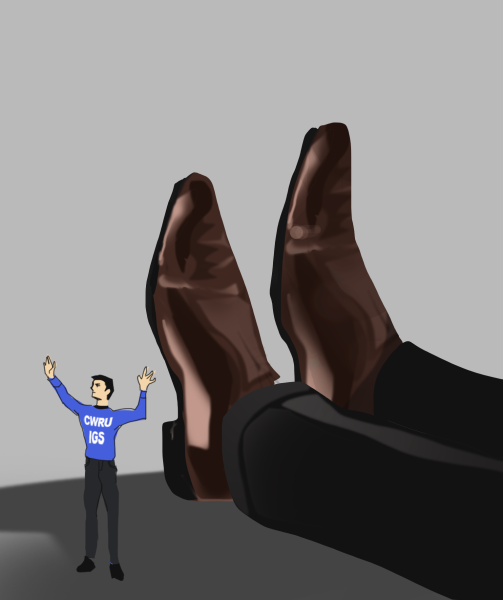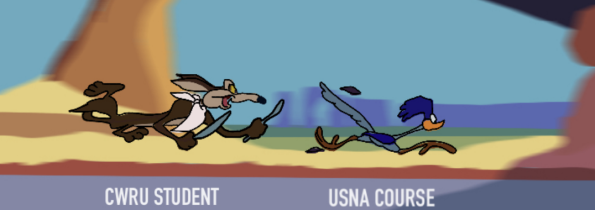Professor’s research sheds light on human transition to bipedality
April 12, 2019
Professor Scott Simpson of the Case Western Reserve University School of Medicine has always been interested in the study of paleontology and evolution of humans. Growing up in a house built in the late 18th century, Simpson remembers his father “poking around” in the ground to find things that had been buried there years before. As a young child, Simpson recognized digging into the earth beneath his feet as an accessible path to history. He ultimately pursued a career in archeology and is now a professor in the department of anatomy at CWRU.
His research for the last 30 years has taken him to the Afar Triangle, a geological depression of Ethiopia in East Africa. Simpson was a specialist studying human evolution the first time he went to Ethiopia in 1992. He continued to return, working on other projects as the paleontologist responsible for the analysis and collection of all human and nonhuman fossils. Five years ago, he established his own project, Galili, and has been working there with his colleagues and students. While the range of fossils available in Ethiopia range between 300,000 and over six million years old, the Galili project focuses on a specific time frame of 3.9 to 4.4 million years ago.
Simpson, through all his education and research, has found humans to be “pretty crazy animals,” in our vast deviations from other mammals. Questions of why humans walk on two legs and why our canine teeth are small while our brains are big are among the many raised during the initial stages of his research. Working in Ethiopia has allowed Simpson the opportunity to answer those questions and prompt others. He emphasized that researching in Ethiopia allows him to study fossils from all different time periods going back millions of years. Studying fossils in the New World, such as the United States, would limit research to the past 20,000 years, when “we’re already humans, we’re already an advanced culture, we already have language,” he said.
Eight to 10 million years ago, humans were quadrupeds, walking on four legs. Simpson’s research has focused on the transition into bipedalism in human ancestors and how human bodies and structure changed as a result.
“When we adopted upright walking, we had to remodel our muscular skeleton,” Simpson explained.
Such evolutionary alterations allow archeologists like Simpson to be able to identify human ancestors from a small foot bone or the shape of the spine or lower limb. There is a lot of anatomical evidence used by scientists to promote the transition to upright walking. Pelvis, foot and leg bones are all very different in humans from mammal counterparts such as chimpanzees, monkeys, apes and even dogs, due to our bipedal walking.
Simpson says there are many problems consequential to the “adoption of bipedality.” These include a human’s ability to break femoral necks, have “bad” knees and hemorrhoids, difficulty in childbirth, hernias and even menopause, while other mammals lack all of these medical issues.
Simpson and his team recently published an analysis of a fragment of a 4.4 million-year-old female skeleton that contributes to ideas of bipedal walking. Not only did she provide pieces of skeleton his team had never seen before but also improved their understanding of how an ancestor her age walked. Scientists are “hard pressed to describe all human beings [from] just one individual,” Simpson said, describing how the discovery and analysis of their most recent skeleton has helped his team appreciate the amount of diversity among human ancestors.
While Simpson is unsure what lessons learned from our ancestors four million years ago can be directly applied today, there is certainly a legacy of human evolution as well as biological and scientific evidence to support that we are all one diverse species.
Through the notable rise in nationalism in Europe and in the United States, Simpson says it is important that people do not dwell on differences between ourselves. As an anatomy professor, Simpson often hears his medical students telling him that their cadavers differ from the pictures in a textbook. Simpson replies that variation is normal, and it is important not to treat minor differences as significant ones. He suggested the same is true in society.
“The things that people pick on to divide people out are trivial,” he said. “It’s not because there is a fundamental difference.”
As a scientist and historian brought together under the focus of archeology, Simpson hopes a greater understanding of biological variation will help people see the importance of differences among a species.
Simpson will continue his research in the Gilili area of Ethiopia, focusing on the time period 3.9-4.4 million years ago, when humans made their final transition to becoming bipeds.























